
Interview: Dirk Müller, Director of Marketing, Coherent Inc.
source:Laser Manufacture News
release:Johnny Lee
Time:2015-09-28
1. LMN: Good day, Dr Müller, nice meeting you at ALAT this year. Could you please introduce yourself briefly at the beginning of the interview?
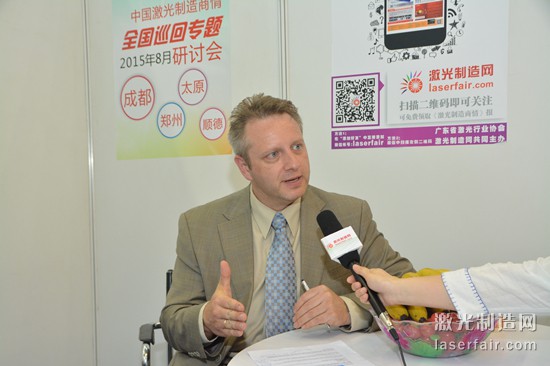
Dr. Müller: Thank you for giving me the chance to speak with you. I’m Director of Marketing at Coherent. Coherent is one of the largest laser companies in the world. In my market segment, I specially look at the microelectronics market. And this market entails a lot of laser-based manufacturing utilized for manufacturing mobile devices in the electronics industry. My role in this position is to make sure that the laser technology of Coherent is well aligned with all the applications that are coming up in the future. So we want to be sure that we provide the best laser solution for manufacturing processes.

2. LMN: Thank you. As we know, Coherent has a famous slogan, “Lasers for any material, any process, any applications.” What’s news about the product line of picosecond lasers?
Dr. Müller: This year, 2015, is a very exiting year for us, because we have a plethora of many different laser products that are coming to the market. We are significantly expending our portfolio in the ultrafast market as we see customers looking for industrial solutions at these pulse durations. We have been able to significantly improve the reliability of femtosecond laser systems . Although ultrafast lasers contain more sophisticated technology, we have been able to figure out how to make these lasers very industrial reliable. They are ready for 24 X 7 industrial applications.
Furthermore, we have seen a lot of the cost come down. There have been internal programs that very much focus on making sure that we can provide a low cost solution to our customers. We also were able to scale the power of our ultrafast laser portfolio at Coherent.
3: LMN: At Asia Laser Forum 2015, you made a speech titled “Industrial Ultrafast Lasers in Manufacturing–Recent Trends”. What’s the most important point from the speech?
Dr. Müller: If I wrap it up in one sentence, I would say: “Speak to us.”
The applications in the microelectronics and micromachining segments are getting increasing complicated. It can be overwhelming for contract manufacture, to figure out what is the best laser, should I be using femtosecond (fs) or picoseconds (ps)? Or is perhaps a CO2 laser best? There are so many different laser types that it has become very difficult for the end customers to figure out what is the best laser.
So we want to encourage people to come to us early in their investigation phase and engage with us about their laser applications. We have application labs throughout the world, in China, Europe, United States etc. We have many of our systems in machines, and we can do state-of-the-art application work. once the customers figure out what is the best laser for their application, we can even guide them toward certain tool builders, because we don’t build tools. We provide the laser, but once the laser process is well established, we talk to tool builders. So the customer can really get the best solution.
4. LMN: With some unique features, ultrafast laser tech can realize super precision manufacturing. Would you please talk about the tech in details? Especially about picosecond laser tech applied in industrial field?
Dr. Müller: There are two components in this question. One is “what do ultrafast laser add to the application”; the other one is “what has happen in the ultrafast laser technology that makes them ready for a prime time.
First let me try to address the first one. We consider ultrafast any laser that has pulses shorter than 10 ps or 15 ps. What we’re finding is that the process principle is different in these shorter pulses than the longer pulses. When you are working with the nanosecond (ns) pulses, what you’re really doing is putting thermal energy into the material surface. You’re heating it up locally and quickly, which is melting and evaporating the material away. So what happens is, there are big chunks of material, molten material that explode away. That process is relatively efficient in terms of removing a lot of material in a short period of time. But it is intrinsically a thermal process. Therefore it will always create heat at the sample. You can try to play some tricks by using small beams or maybe harmonics like UV and green, in order to ameliorate the thermal effects. But fundamentally it’s a very thermal process.
What’s completely different when using ultrafast lasers is that you’re not actually heating the material, but instead you are breaking the molecular bonds, so your photons actually are breaking the bond between the molecules and now the molecules vaporize. You really don’t have the liquid phase but instead the material goes instantly from a solid state into a vapor state. From a physics point of view, that process is much more “energy hungry”. You need more energy to break all those bonds. But what you get in return is a process that introduces much less heat into the surrounding material, because the pulse is so short that is disappears before it can actually spread within the material. Heat spreading inside the material has a characteristic time scale. It’s usually something that in the scale of maybe a few hundred picoseconds or few nanoseconds. So if you’re using a pulse that is much shorter than that, the material does even know what’s happening. So the surrounding material never heats up. That’s really the fundamental difference between ps laser and ns laser, or fs laser and ns laser. This is on the application side.
The thing we are very excited about on the laser side is thatwe have exposed them to much more rigorous testing in the recent years. All the lasers that have been developed by Coherent in the last a few years have undergone strict HASS and HALT testing. During highly accelerated life-time testing, we expose the laser systems to very harsh environmental conditions. We put them into chambers, wher we heat up the laser chamber to 40 or 30 degrees, and we suddenly cool down the laser system to negative temperature -10 or -20 degrees. We expose them to humidity, and our expectation is nothing changes inside the laser, that it just keeps on running.
So once the laser passed this very rigorous test, we’re confident that: A) the laser is very well built in order to survive shipping (shipping company don’t always treat lasers nicely); B) it can also withstand harsh environmental conditions at the factory. This is something that has become a core philosophy of Coherent: making sure all the lasers are exposed to the harshest tests.
5. LMN: Would you please share with us the trends of picosecond lasers’ application?
Dr. Müller: OK. This is a broad question, for there are so many applications that ps laser and fs laser are playing a role in right now. But I guess if you step back for a moment, what we are seeing is that everything is getting smaller. Your cell phone is getting smaller, more features, laptop is getting more compact. Everything is shrinking in size, and that means mechanical machining is becoming more challenging.
Fortunately the feature sizes cater to the advantages of lasers. Feature sizes in the 10s of microns range, like maybe 10, 20, 30 or 40 micron features, are very well suitable for laser process. Processes that in the past were done with mechanical tools can now be done with lasers, because the feature sizes match so well. So lasers are really seeing a sweet spot, as mechanical methods are coming to an end, and are reaching barriers, the laser can take over. This applies to all laser processes, but more specifically, it applies to ultrafast laser, because ultrafast lasers have the ability to locally only machine a small area without affecting the surrounding. There are so many applications these days, wher you only want to influence the material locally, but you don’t want to have any of the surrounding influenced. That’s sort of the bird eye view of why ultrafast laser applications are becoming more and more prevalent.
If I now go to the details, you can see what’s happening to the applications. Any time, you have a material that’s difficult to machine with other lasers, that’s wher ultrafast laser can come in. Ultrafast laser literally can machine any material, carbide, diamond or silicon etc. Whenever other lasers or mechanical processes have difficulty people look at ultrafast lasers to solve their problem, for example, sapphire. Sapphire is one these materials which is very tough, very hard. There are few laser processes that are able to cut or to drill sapphire. You can do it mechanically, but your tools wear out, so you have to replac and recalibrate them. You have wear and tear. Laser processes are really fantastically suited in order to machine sapphire.
Another material which works very well is glass. Glass has the property that it doesn’t conduct heat very well. So it’s very sensitive to heat, which means if you expose it to a laser that machines by heating up material, it will start to crack. So glass is one of those materials that are very suited for ultrafast lasers, because ultrafast laser pulses are very gentle on glass.
This is not the only material, there are materials like thin-film. In the semiconductor industry, you often have stacks of very thin film evaporated on the wafer. These films might be very sensitive against delamination. If you expose the material to heat, you can have delamination and heating. So that’s another application wher ultrafast lasers do really well. These are a few small glimpses of the technology that we see taking a hold in ultrafast community.
6. LMN: What do you think about picosecond laser market in 5 years?
Dr. Müller: We’re very optimistic about the picoseconds laser market and about the femtosecond market. We’ve already seen a tremendous growth over the last 3 or 4 years, but I do believe we are only seeing the beginning of it. There will be so much growth to come. So I could see that the use of ultrafast lasers will become very similar to the use of nanosecond lasers, or nanosecond UV lasers.
There are a lot of challenges ahead of us, and I think we have only seen the tip of the iceberg for these ultrafast applications.
about LMN
Laser Manufacture News is the most influential laser magazine in China. It aims to completely analyzing laser industry chain, promoting the development of laser industry.
Laser Manufacture News has built good relationships with a lot of laser enterprises and institutes. With years hard efforts of the staff, now its printed circulation reaches 20,000 copies per month and online version delivery through email reaches 50,000, covering all over China and some foreign countries, and winning high praise and concern.
www.laserfair.com
www.laserfair.com
MOST READ
- RoboSense is to Produce the First Chinese Multi-beam LiDAR
- China is to Accelerate the Development of Laser Hardening Application
- Han’s Laser Buys Canadian Fiber Specialist CorActive
- SPI Lasers continues it expansion in China, appointing a dedicated Sales Director
- Laser Coating Removal Robot for Aircraft
PRODUCTS
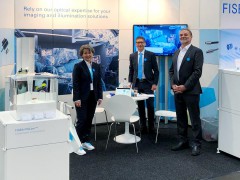 FISBA exhibits Customized Solutions for Minimally Invasive Medical Endoscopic Devices at COMPAMED in
FISBA exhibits Customized Solutions for Minimally Invasive Medical Endoscopic Devices at COMPAMED in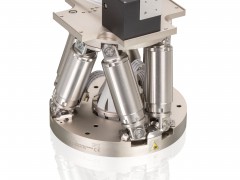 New Active Alignment System for the Coupling of Photonic Structures to Fiber Arrays
New Active Alignment System for the Coupling of Photonic Structures to Fiber Arrays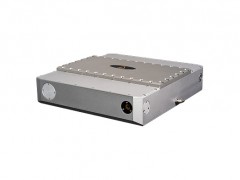 A new industrial compression module by Amplitude
A new industrial compression module by Amplitude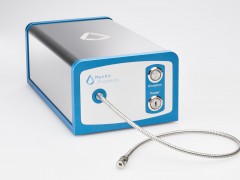 Menhir Photonics Introduces the MENHIR-1550 The Industry's First Turnkey Femtosecond Laser of
Menhir Photonics Introduces the MENHIR-1550 The Industry's First Turnkey Femtosecond Laser of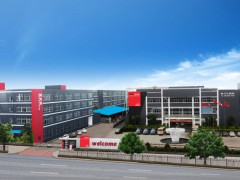 Shenzhen DNE Laser introduced new generation D-FAST cutting machine (12000 W)
more>>
Shenzhen DNE Laser introduced new generation D-FAST cutting machine (12000 W)
more>>
